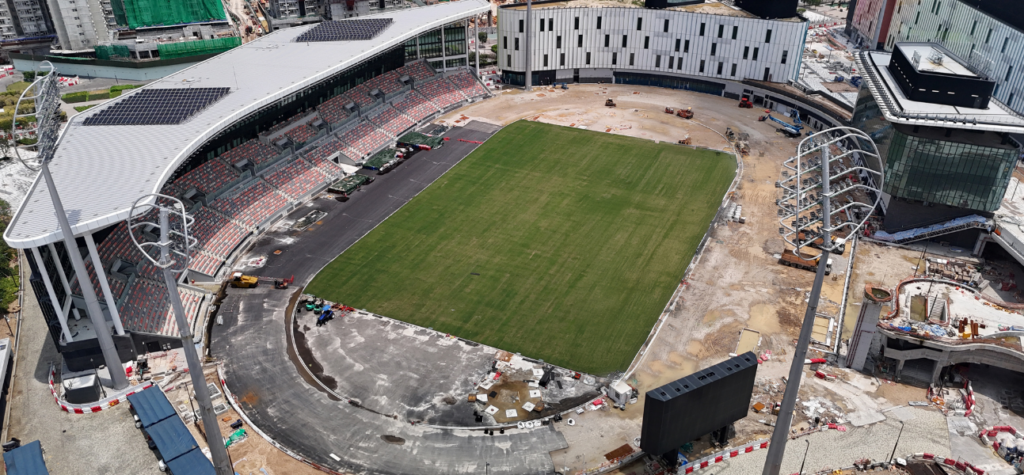Images: Xtract One
Xtract One Technologies is an AI-powered security technology company dedicated to driving the digital transformation of physical security. The company’s solutions provide scalability, actionable insights and cost effectiveness while preserving the patron experience.
Peter Evans, CEO of Xtract One, discusses how the company’s SmartGateway technology can provide a seamless experience for venue operators and guests alike…

Is the Walk-Through Metal Detector Obsolete for Security?
For years, walk-through metal detectors (WTMD) have been the go-to solution for patron security screening in public spaces. However, with recent advances in sensor and processing technology, these devices are becoming increasingly outdated and can even be considered obsolete technology.
Challenges of legacy Walk-Through Metal Detectors
- Processing time is slow due to the need to divest all personal items and yet there are still high nuisance alarm rates which guards need to resolve.
- As a result of having slow processing time, more WTMDs are required to achieve a given throughput. Therefore, the costs of operating a fleet of WTMDs is high: large numbers of systems, multiple guards per system, and a significant amount of space is required. And in many locations x-ray scanners are also used thereby further increasing operating costs.
- There is a high level of close contact between visitors as they wait in the queue, and between visitors and guards at the WTMD itself. Many patrons find this invasion of personal space offensive. Further, close human proximity makes it easier for infections to be transmitted.
- Organisers of any event that needs to screen large numbers of patrons in a short time, such as sports events, know that there will be long queues and mounting frustrations for patrons and guards alike, potentially leading to disturbances.
- Many systems are susceptible to environmental interference, for example wind can move the WTMD structures, and create further nuisance alerts.
Security is complicated
There are many conflicting drivers within a security process – these are driven by the different objectives of the various stakeholders.
- Security. There is a need to prevent threats, especially mass casualty threats entering the venue.
- Marketing/Customer Experience. There is a desire to allow patrons to enter the venue as quickly as possible. Visitor experience is important. Many venues recognise that revenue is lost while people are standing in a queue and reduced if they have a stressful security experience.
- Operations. There is a need to contain costs, recruit staff and yet maintain flexibility for different types of events. A change in the requirements of any one factor impacts many other facets:

Balancing all these areas of the business is extremely difficult. Fortunately there are new technologies such as the Xtract One SmartGateway that provide venues with the ability to better address the conflicting requirements.
New Generation Weapon Detection Systems – making a better first impression
The Xtract One SmartGateway combines multi-sensors and AI to deliver a more comprehensive, accurate, and cost-effective security solution.
By embracing the SmartGateway, venues can enhance their overall security operations, provide a safer environment for employees and customers, reduce throughput time, reduce or eliminate queues, and free up more space at the venue entrance.
SmartGateway focuses on detecting weapons (guns, knives etc) and allowing visitors to walk through without the need to divest personal items such as phones, keys and other metallic items.
As there is no need to stop and divest, throughput is increased and queues are quickly dispersed.
There are also significant economic benefits – although old technology WTMDs are cheap, their slow throughput requires multiple systems and many guards – and the guards are costly.
For example, Moody Center (pictured, a 15,000-seat arena in Austin, Texas) required 42 WTMDs and 84 guards. These were replaced with nine SmartGateway systems which require only 27 guards. At a recent Harry Styles concert, over 10,000 visitors were screened in less than 25 minutes.
Many venues benefit from the latest technology
The advent of SmartGateway weapons detection technology, that differentiates between threat objects and benign objects, reduces queues and uses less space, is improving the user experience and security process for a diverse range of facilities.
Stadiums. The challenge for stadiums is how to get huge numbers of people in and out safely in typically short periods of time, and for the crowd to be feeling safe, and not frustrated from queues. Many stadiums have already been the first adopters of such technology.
Theme Parks. Travelling with the family can be a challenge on most occasions, but having impatient kids waiting at the door and being delayed by the security checks is surely one of the most stressful experiences that parents have to endure, and operators know this. Utilising high throughput weapons detection technology is proven to be a significant stress reliever for patrons – and gives the family more time in the park.
Performing Arts Centres, Museums and Art Galleries. Such venues find that old style security checkpoints are completely at odds with the welcoming, aesthetically pleasing and peaceful environment expected by patrons.
As advancements in security continue, the future of security screening is looking bright, with innovative solutions promising more efficient and effective screening processes.
Join Xtract One and hundreds of sports and entertainment execs at The Wave in Kwun Tong, Hong Kong on 19-20 October as we explore the future of design, operations and technology for Asia’s sports and entertainment venues – only at TheStadiumBusiness ASIA 2023.






Share this